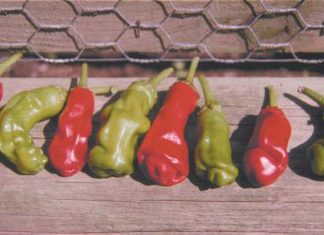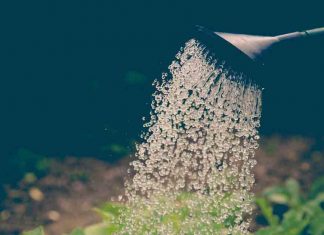| Issue #47 • September/October, 1997 |
Most homesteaders and country dwellers forage a little. It might be hunting for morels in the spring, berries in the summer, or boletes in the fall. Some forage salads, some go looking for a supply of autumn nuts for their holiday baking. The hardcore forager does all this and more.
When a visitor to your garden compliments you on your chenopodium as well as your tomatoes, you know he’s a hardcore forager. Where you see a blaze of summer beauty in a stand of day lilies, the hardcore forager sees fritters and cooked buds and a salad made with the tubers. A lake fringed with cattails is liable to bring paroxysms of joy in the hardcore forager. There are flour, vegetables, and even something for the pickle crock there, not to mention a meat course of fish or frog legs. Experienced foragers see food, medicine, and other useful things in every forest and field.

Day lily |
A reliable guide book
Becoming a hardcore forager is not difficult. It takes a fair amount of time to learn the basics of foraging, then a lifetime of honing those basic skills. The first thing to do is to find a reliable guide book to learn which plants are good for what. The classic in the field isStalking The Wild Asparagus, by the late Euell Gibbons. He originally published it in 1962, and Gibbons’ love of the wilds (and wild foods) still shines forth 34 years later. The line drawings are very clear and make recognition easy. The recipes will get the novice wild-foods cook off to a good start.Stalking The Wild Asparagusis available from Storey Communications, Schoolhouse Rd., Pownal, VT 05261.
Another basic manual of identification and use of wild plants isThe Wild Food Trail Guideby Alan Hall. Sadly, this book is out of print. It might be found in used bookstores, or your library may be able to get you a copy via inter-library loan. This is a more compact book than Gibbons, but it has excellent indices, listing plants by use and season of availability. The section of potentially harmful look-alikes is also very handy. Oddly enough, the little Golden Nature Guides are useful for identification as well. While there isn’t one on edible plants specifically, the one on flowers and the one on weeds both have excellent pictures for identifying your targets. The various guide books with photographs don’t seem to be as useful. Sometimes it’s hard to see the plant in question in the photograph. A clear line drawing is your best bet.
Now you have your book and you’re ready to go. Almost. Book in hand, take a stroll in the backyard. Try to identify the edible wild plants right outside your back door. Odds are you’ll have no trouble finding half a dozen or so. The most likely are dandelion, chicory, amaranth, rumex, chenopodium, and milkweed. These, along with cattails, are the most common edible plants in America.
When gathering wild plants, try to take only what you need. For example, if you’re gathering chenopodium leaves for supper, just clip off the leaves, not the whole plant. While it may be more convenient to take the plant and separate the leaves at home, by only taking some of the leaves from each plant, you ensure that you (and other foragers) will have a new crop in a few weeks. There are some plants that you end up destroying while gathering, though. These include spring beauties, day lilies (when digging the tubers), and Jerusalem artichokes. Some patches can be heavily harvested, some should be left alone. Always be sure to leave enough for the next generation of plants to grow.
Tools
The question, once you’ve found your plants, is what to do with them. For gathering plant foods, you’ll need some basic tools.
A good qualitytrowelis necessary for digging out roots and tubers. Avoid the cheap ones stamped out of sheet metal. They soon bend and break under steady use. A trowel with a solid shaft and a wooden or metal handle is well worth the investment.
A pair ofkitchenshearsis good for cutting leaves, etc., from the main plant. These can be had for relatively little at any kitchen store.
Apocket knifeis handy for a multitude of purposes. Avoid the cheap knives and invest in a good one. It doesn’t hurt to check the clearance shelves at the local discount store. A recent visit to Wal-Mart revealed Victorinox Bantam models (single blade, can opener, bottle opener, screw driver, wire stripper, key chain, tweezers, and toothpick) for $2.50. The original price was $6.97.
A fistful of quart or gallon sizesealable plastic bagswill help you get your treasures home. This all can go into your pockets or afanny pack. If an extended gathering trip is planned, aknapsackor haversack can be used to keep your hands free. On shorter trips, anet shopping bagcan be stuffed into a corner to help cart home the loot.
Safety
When gathering wild foods, be aware of the area you are working in. It is wise to avoid roadsides. Auto exhaust contains various compounds that can collect in roadside plants. These are not substances that you want to eat. Also, runoff from roads usually includes oil and gasoline. This is not anything you want to eat, either. Be careful of wild plants along cultivated fields. Some farming practices include the use of a variety of herbicides and pesticides that you definitely do not want to bring home.

Dandelion |
Once you’ve identified your plants, and have a safe place to harvest them from, go out and get some. In general, the young leaves are milder in flavor and more tender. Gather those instead of the older leaves. At first, take only enough for a sample. This is a reasonable precaution, since you cannot be sure if you’ll like the flavor, or if the plant will agree with your system.
A good example is the Jerusalem artichoke. The root of a sunflower (Helianthus tuberosus) containsinulin, a chain of fructose molecules. Inulin is the same thing that causes flatulence from beans. But where beans are 10-15% inulin, Jerusalem artichokes are as much as 50% inulin. Therefore, eating them can cause flatulence, in some cases terribly painful flatulence. So don’t eat a large helping of them until you know exactly how they react with your body. Day lily tubers can have the same effect.
The general rule is toavoid plants that have milky sap. The exceptions to this are dandelion and milkweed. To be safe to consume, the plant must not irritate the skin. A rough and ready allergy test is to scratch the inside of your elbow and apply a bit of the plant in question. Hold it in place with a bandage for 24 hours. If there is a reaction (swelling, redness, etc.), then you may be allergic to that plant.Do not eat it. If it passes the allergy test, eat asmallsample. A few leaves will be enough. If there are no ill effects within ten hours, then that plant is safe for you to eat. This is a bit of a rigmarole, but it is necessary for your safety and well-being.
Preparing wild foods
Once you’ve determined that the plants you have collected will not cause you any undue difficulty, you need to prepare them. Milkweed, dandelion, and rumex, for example, all contain various bitter components that must be removed before eating. The easiest way to do this is to put the plant material in boiling water, boil it for a few minutes, drain, and repeat. Do this two or three times. The last time, cook until tender.
The various greens all have their own flavors, and can be combined to make interesting dishes. They may be used as one would use spinach. Amaranth greens are used in making a cream soup. Rumex can make an excellent sauce for pork or duck. The young leaves of dandelion, rumex, and chicory are very tasty when cut up into a salad with iceberg lettuce. They tend to be bitter, but this bitterness is much less in young leaves and works well with the bland lettuce. Use your imagination, read your cookbooks, and you’ll find many niches in your diet for wild plants. They not only provide greens (these are the most common and easiest to gather), but a variety of cooked vegetables, seeds for flour and porridge, items for the pickle crock, and a number of seasonings and thickeners.
Fish
Once you have gotten used to using wild plants, it’s time to consider wild meats. Probably the easiest to use and most readily available are fish. Unless you live in a desert, there is fishing nearby. The most common fish are the sunfish. These include bream, bluegills, pumpkinseeds, warmouth, rock bass, and even the large mouth and small mouth bass. Almost any pond or lake that has fish has sunfish, and they’re easy to catch.
The ideal rig is an ultra-light casting rod and reel with four-pound test line and a number 8 or 10 hook. A pencil bobber completes the outfit. Bait can be red worms, leaf worms, meal worms, or wax worms. I like wax worms because their tough skin allows them to be used to catch several fish. Simply bait your hook, set your bobber so that the bait will more or less drop to the bottom, and cast. The hook is weight enough to make the bait sink, but without detracting from a natural appearance. Usually, the fish will take the bait while it’s still sinking. If not, let it sit for a few minutes, and then reel it in very slowly. The movement will often provoke a strike.
Try for sunfish around piers and platforms, and in shallow weedy waters. In some ponds, you’ll find many short, thick fish. These fish are stunted due to overpopulation, and every one that you catch should be kept. This provides more room for the remaining fish to grow larger. Even the very smallest sunfish are useful. If too small to eat, they can always go into the garden as fertilizer. This same fishing rig, with a slightly larger hook, can be baited with worms and used to catch bullheads and catfish.
Cleaning a multitude of small fish can be very time-consuming, so fillet them instead. Each little sunfish will give two small fillets, about the size of a silver dollar. They don’t look like much, but dipped in a batter of beer and pancake mix, they puff right up. This method of cooking avoids the many bones, and allows a little to feed a lot. Small catfish and bullheads are good fried whole, or they can be smoked. Either way, these fish are good eating.

Amaranth |
Frogs
Frogs are another readily available wild meat. Only the legs are eaten. While bullfrogs are the most popular source of frog legs due to their size, any reasonably sized frog can be eaten. Frogs can be taken a number of ways. They are usually hunted at night, when they’re most active. Bare minimum equipment for frog hunting is a strong flashlight, assuming that your state allows lights for frogs. By shining this light in the frogs’ eyes, you dazzle them. Keeping the light in their eyes, you can just pick them up. Usually. If you want to be a bit more sure about collecting your frogs, you can use a gig. This is a four- or five-tined spearhead available at almost any sporting goods or discount store. Fix it to a shaft, and spear the frog through the body. Air guns, .22’s (loaded with CB caps), and archery tackle can also be used for hunting frogs.
Of course, the meat on a frog is all on the legs. Simply cut them from the body, slip the skin off, and cut off the feet. The traditional way of cooking frog legs is frying. Any coating can be used, from bread crumbs to cornmeal to commercial mixes. Season your chosen coating to taste, dip the legs in the coating, then into beaten egg, and finally into the coating again. Then fry until nicely brown in a little oil.
Turtles
Local waters may also offer a third meat for your table: turtles. Terrapins and snapping turtles have graced many fine menus around the world, commanding high prices These esteemed animals are yours for the taking. Snapping turtles are large and rather vicious. Certainly they fear little or nothing in their environment. Therefore,caution should be used in handling them. The heavy, beak-like jaws can sever a broomstick, or a finger,quite readily. Snappers must be handled very carefully. Usually, they can be carried by the tail, and neither the head nor the claws can get you. Terrapins are easy to handle, since they tend to pull into their shells. Simply grasp them by the sides.
Catching turtles isn’t hard at all. The lazy man’s way is to use jug lines. A large fish hook is snapped onto a wire leader, and the leader is attached to a plastic jug by a length of line. Chicken livers make a good bait. These are then dropped into the pond or lake of your choice. They can be left overnight, to be retrieved in the morning, or they can be tended from a boat during the night. If you decide to leave them overnight, make sure that you have some way of retrieving them.
Another way to obtain your turtle is with a trap. There are two basic traps. The first is a barrel or other large container with bait inside and a ramp leading up to the edge. This works best if the barrel is sunk about halfway into the water, with holes punched in the sides to allow the aroma of the bait to disperse. The turtle climbs the ramp, falls into the barrel, and cannot climb out. A variation of this trap uses a frame covered with hardware cloth, having metal sheathing around the top so the turtle can’t get out. The other turtle trap is similar to a fish trap. Hardware cloth is secured to a square frame to make a box. On one side, a flattened funnel is made. The turtle enters the trap and cannot get out. Bait for these traps can be fish or any other dead meat.
Preparing turtles
Preparing turtles is relatively easy. Snapping turtles are best killed by chopping off the head. Since they tend to stick out their heads when held by the tail, one person can hold the turtle up over the chopping block, and another can use an ax or hatchet to cut off the head. The snapper should then be hung up to bleed out. Once bled, the carcass should washed with plain soap and a stiff brush. After cleaning, the tail can be skinned and the lower shell cut off. The internal organs are all removed, preserving the liver and any eggs that might be present. Be sure to carefully remove the gall bladder, the little green bag on the liver.
To make soup, the carcass, liver, eggs, and lower shell are put into a kettle with a bay leaf, some cloves, thyme, and allspice, covered with water, and simmered until the meat falls off the bones. Then remove the turtle and let it cool. When cool enough to handle, remove all the skin, bones, claws, and shell. Chop the meat, liver, and eggs and return to the broth. Sauté onions and garlic until translucent, add flour to make a roux, and finally add crushed canned tomatoes or tomato juice. Simmer for a few minutes. Add this mixture to the turtle meat and broth, bring to a boil, and serve.

Milk weed |
If you want to use the meat in other ways, the turtle can be cleaned and simmered as described above, and then the meat can be used in salads, omelets, stir fry, or other dishes. Smaller turtles are handled in a manner similar to crab or lobster, in that they are dropped into a pot of boiling water and cooked for 10 minutes or so. The turtles should be scrubbed and rinsed before cooking. Cleaning and use of the meat is the same as for the bigger turtles.
Crayfish
The final aquatic meat is the crayfish. These little crustaceans look like miniature lobsters, and taste similar to shrimp. They range across the country, in various species, and can be taken in several different ways. Water-dwelling crayfish can be picked up by hand (grasping them just behind the pincers to avoid a nip), caught in traps (like fish traps or lobster pots), or hauled in with nets, or even strings baited with bacon rind. Some live in low fields, tunneling down to the water level and leaving “chimneys” of mud. These are most easily gathered at night when they prowl about for food. In the South and in Hawaii, some live on crops and can be gathered as they travel between the fields and their homes.
Preparing crayfish is very easy. Simply drop them into boiling water and let then simmer for about 10 minutes. The water can be seasoned as for crab or shrimp. The cooked crayfish are then removed and cooled under running water. The tails can then be twisted off and the shell peeled away. Slide a fingernail or knife along the midvein to clean out the muck, and your crayfish is ready to eat. The cooked and cleaned tails can be served in the same manner as a shrimp cocktail, coated with cornmeal and fried, used in salads or stir fry, or however you would use crab or shrimp.
When gathering wild foods, whether plants or animals, always be sure that you are not breaking any laws. Some areas, such as forest preserves and parks, have restrictions on gathering plants. In some places, turtles and frogs are considered game animals and are regulated by law. Check with your local conservation office to avoid violations.
If you are foraging on private land, get the land owner’s permission. Many land owners are happy to let someone come and pick “weeds” if that person acts responsibly. Always forage only where given permission, and for the materials agreed upon. You might find other foods while in the field, but the land owner may be saving them for himself. Never leave a mess, and always leave farm gates as you find them. Like hunters and fishermen, foragers have to make a good impression to keep private land open to use.
This is not the last word on foraging. There probably will never be a last word. People will continue to discover the delights and rewards of foraging for generations to come. It helps us to appreciate what we have in the modern world, and to appreciate the wonder and diversity of nature.














